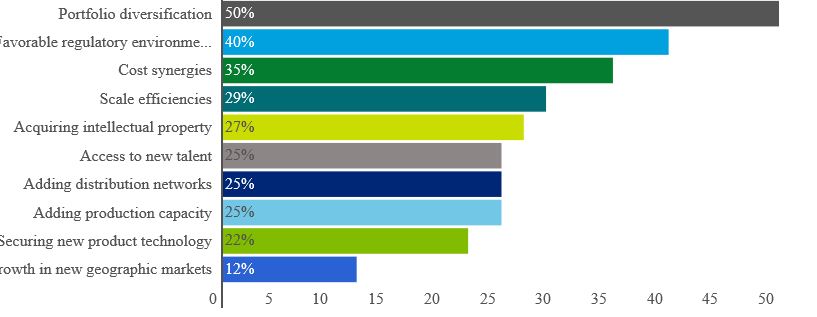The Risks And Rewards Of Cross-Border M&A.
Survey results: Global executives on investing abroad
Cross-border mergers and acquisitions (M&A) have emerged as a way to quickly gain access to new markets and customers—and global trends point to increasing deal volume. But as cross-border deal activity continues, companies will need to weigh the risks and rewards of engaging in these ventures against making greenfield investments.
Cross-border M&A
To better understand the risks and rewards associated with cross-border deals, Deloitte conducted a survey of more than 500 client executives with cross-border M&A experience across regions, industries, and functions. In addition to the United States and Canada, executives also represented APAC, EMEA, and LATAM regions.
Our survey report, "Cross-border M&A: Springboard to global growth," indicates that firms are becoming more competent and experienced in cross-border acquisitions—acknowledging the importance of comprehensive planning, tapping the expertise of external advisors, using thorough due diligence—and are thus able to deliver on their deal objectives. However, executives remain cautious as they navigate the murky waters of global economic and political instability.
To help executives navigate common international integration issues, we’ve also developed a follow-on report, "Seize synergies: Managing country specific integration complexities," that includes multiple case studies and walks through, in detail, the main sources of delay that threaten the shareholder value typically driving integration in the first place.
Cross-border M&A: Springboard to global growthDownload the PDF
Seize synergies: Managing country specific integration complexitiesDownload the PDF
Strong appetite for cross-border M&A
Survey respondents identified drivers that create a compelling business case for cross-border M&A. These include saturation or slowdown in core markets and need for diversification, regulatory uncertainty in home markets and high repatriation costs of overseas earnings, and technology and productivity enhancement synergies.
Top strategic deal objectives

Source: Deloitte analysis through primary survey.
Value might not add up to 100 percent because respondents could select more than one answer.
Acquiring companies may have to recalibrate their perceptions of risk and their traditional due diligence process to address risk factors that accompany cross-border M&A transactions. The deal team will need to focus on common risk factors such as national and regional tax laws; the availability, accuracy, and reliability of the target company’s financial information; the country’s political stability; and the target’s compliance with the US Foreign Corrupt Practices Act, and similar anti-bribery, and anti-money laundering regulations.
Top risk factors for cross-border M&A deals
The critic: The critical importance of integration planning
When reflecting on their regrets from prior cross-border M&A deals and opportunities for improvement, 33 percent of executives said they want to place more emphasis on comprehensive pre-and post-deal planning, 32 percent want to be more aggressive in negotiations, and 31 percent want to conduct more research on a target’s market potential and company culture. From a regional perspective, respondents in LATAM and APAC shared similar regrets around integration, and initial target research.
Opportunities for improvement in future cross-border M&A deals
What’s behind common international integration issues?
Global integration activities are complex and may result in delays arising from several sources. Delays from failing to thoughtfully plan the global integration strategy and country-specific integration sequencing could lead to unrealized deal synergies, disruptions to operations, legal challenges, and—in extreme cases—abandonment of the integration.
Corporate legal and regulatory considerations—Enterprise-level, country-specific legal and regulatory issues involve specific expertise and often mandate long lead times. Three types of issues are common: labor issues, minority investment issues, and anti-trust and tax issues.
Product registration and industry-specific regulations—Extensive due diligence is essential to understanding industry-relevant product registration, certification, and labeling requirements in highly regulated industries including life sciences and health care, chemical and consumer goods, and financial services.
Legal entity (LE) rationalization—Large integrations often result in overly complex LE structures that are misaligned with corporate strategy and drive up administrative costs. Three common areas of concern are structure simplification, registration and licensing, and local engagement.
The importance of a country sequencing plan: Consider this data-driven, three-step approach

Areas of focus for executives considering cross-border M&A
To be able to fully realize post-deal synergies and shareholder value, executives should focus on due diligence, planning, and execution when developing and implementing their country integration and sequencing plans.
Due diligence
Know your countries: Collect all company data and regulatory requirements to inform country sequencing decisions.
Planning
Start early: Stand up local and regional teams early in the integration process (and begin planning before deal close) so that Day One processes can run smoothly.
Emphasize speed to value: Develop a plan for efficient integration that emphasizes targeting synergies (financial, sales, employee) that can be realized quickly.
Execution
Manage centrally, implement locally: Develop a cohesive central governance structure but engage in-country teams to execute.
Expect roadblocks: Consider mitigation steps early and move quickly to help overcome hurdles when they are encountered.


